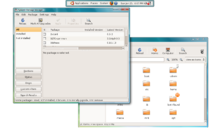Cooperative Linux
 | |
| Original author(s) | Dan Aloni |
|---|---|
| Developer(s) | Community |
| Initial release | January 25, 2004 |
| Final release | |
| Operating system | Windows NT family |
| Type | Platform virtualization |
| License | GNU General Public License |
| Website | www |
Cooperative Linux,abbreviated ascoLinux,is software which allowsMicrosoft Windowsand theLinux kernelto run simultaneously in parallel on the same machine.[2]
Cooperative Linux utilizes the concept of a Cooperative Virtual Machine (CVM). In contrast to traditionalvirtual machines,the CVM shares resources that already exist in the hostOS.In traditional VM hosts, resources are virtualized for every (guest) OS. The CVM gives both OSs complete control of the host machine while the traditional VM sets every guest OS in an unprivileged state to access the real machine.
Overview
[edit]
The term "cooperative" is used to describe two entities working in parallel. In effect Cooperative Linux turns the two different operating system kernels into two bigcoroutines.Each kernel has its own complete CPU context and address space, and each kernel decides when to give control back to its partner.
However, while both kernels theoretically have full access to the real hardware, modern PC hardware is not designed to be controlled by two different operating systems at the same time. Therefore, the host kernel is left in control of the real hardware and the guest kernel contains special drivers that communicate with the host and provide various important devices to the guest OS. The host can be any OS kernel that exports basic primitives that allow the Cooperative Linux portable driver to run in CPL0 mode(ring 0)and allocate memory.[3]
History
[edit]Dan Aloni originally started the development of Cooperative Linux as a research project based on similar work withUser-mode Linux.[4][5]He announced the development on 25 Jan 2004.[6]In July 2004 he presented a paper at the Linux Symposium.[7]Thesourcewas released under theGNU General Public License.Other developers have since contributed various patches and additions to the software.[8]
Comparisons
[edit]Cooperative Linux is significantly different from fullx86 virtualization,which generally works by running the guest OS in a less privileged mode than that of the host kernel, and having all resources delegated by the host kernel. In contrast, Cooperative Linux runs a specially modifiedLinux kernelthat isCooperativein that it takes responsibility for sharing resources with the NT kernel and not instigatingrace conditions.
Distribution
[edit]

Most of the changes in the Cooperative Linux patch are on thei386tree—the only supported architecture for Cooperative at the time of this writing. The other changes are mostly additions of virtual drivers: cobd (block device), conet (network), and cocon (console). Most of the changes in the i386 tree involve the initialization and setup code. It is a goal of the Cooperative Linux kernel design to remain as close as possible to the standalone i386 kernel, so all changes are localized and minimized as much as possible.
The coLinux package installs a port of theLinux kerneland avirtual network deviceand can run simultaneously under a version of the Windows operating system such asWindows 2000orWindows XP.It does not use avirtual machinesuch asVMware.
Debian,Ubuntu,FedoraandGentooare especially popular with the coLinux users.
Due to the rather unusual structure of the virtual hardware, installing Linux distributions under coLinux is generally difficult. Therefore, users in most cases use either an existing Linux installation on a real partition or a ready made filesystem image distributed by the project. The filesystem images are made by a variety of methods, including taking images of a normal Linux system, finding ways to make installers run with the strange hardware, building up installs by hand using the package manager or simply upgrading existing images using tools likeyumandapt.An easier way to get an up-to-date filesystem image is to useQEMUto install Linux and "convert" the image by stripping off the first 63 512-byte blocks as described in the coLinux wiki.
Since coLinux does not have access to native graphics hardware,X Windowor X Servers will not run under coLinux directly, but one can install[citation needed]an X Server under Windows, such asCygwin/XorXmingand useKDEorGNOMEand almost any other Linux application and distribution. All of these issues are fixed by using coLinux based distributions such as andLinux, based on Ubuntu, orTopologiLinux,based onSlackware.
Dedicated distributions
[edit]A few distributions were built specifically to work with coLinux.
Emulated hardware
[edit]Limitations
[edit]- Does not yet support 64-bit Windows or Linux (nor utilize more than 4GB memory), but a port is under development by the community.
- No multi-processor (SMP) support. Linux applications and the underlying kernel are able to use only one CPU.[11]
See also
[edit]- Win32-loader
- Platform virtualization
- Comparison of platform virtualization software
- Cygwin
- MSYS
- Wubi (installer)
- Longene
- Chroot
- Windows Subsystem for Linux
References
[edit]- ^ab"Cooperative Linux Documentation".Archived fromthe originalon 2023-05-13.Retrieved2020-08-08.
- ^"coLinux main website".Archived fromthe originalon 2018-05-19.Retrieved2004-04-13.
- ^"coLinux main page".Archived fromthe originalon 2015-12-04.Retrieved2004-04-13.
- ^"Open source contributions | Dan Aloni".blog.aloni.org.Retrieved2022-01-08.
- ^"Cooperative Linux Active Development Team Members".colinux.org.Retrieved2022-01-08.
- ^"LKML: Dan Aloni: [ANNOUNCE] Cooperative Linux".lkml.org.
- ^"Dan Aloni paper presented July 2004 at Linux Symposium"(PDF).Archived fromthe original(PDF)on 2018-09-30.Retrieved2008-03-30.
- ^Aloni, Dan (2021-11-17),da-x/colinux,retrieved2022-01-08
- ^Reed, Michael (2011-09-06)."andLinux: Seamlessly Run Linux Applications on Windows".Linux Journal.Retrieved2023-10-06.
- ^"So bringen Sie Linux unter Windows zum Laufen".WWW.TECCHANNEL.DE.Retrieved2023-10-07.
- ^"FAQ".coLinux.
